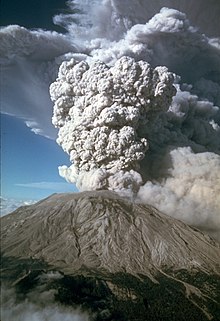Ejecta

Ejecta (from
Volcanology
Typically in
Ejecta can consist of:
- juvenile particles – (fragmented magma and free crystals)
- cognate or accessory particles – older volcanic rocks from the same volcano
- accidental particles – derived from the rocks under the volcano
These particles may vary in size; tephra can range from ash (<1/10 inch [0.25 cm]) or lapilli (little stones from 1/10 to 2+1⁄2 inches or 0.25 to 6.35 centimetres) to volcanic bombs (>2.5 inches [6.4 cm]).[3]
Planetary geology
In planetary geology, the term "ejecta" includes debris ejected during the formation of an impact crater.
When an object massive enough hits another object with enough force, it creates a
Ejecta features are classified based on their distance from the impact crater, the appearance of the ejected material, and the geomorphological characteristics of the terrain. Some common ejecta features include ejecta blankets, radial and concentric ejecta patterns, and secondary craters.[5]
Ejecta Blankets: Ejecta blankets are the continuous layer of debris that surrounds the impact crater, thinning outwards from the crater's rim. The composition of the ejecta blanket can provide valuable information about the geological composition of the impacted surface and the projectile that caused the impact. The distribution and morphology of the ejecta blanket can also provide insight into the impact angle and the dynamics of the ejecta emplacement process.[6]
Radial and Concentric Ejecta Patterns: Radial ejecta patterns are characterized by the outward distribution of ejecta from the crater in a series of rays or streaks. These rays are often more prominent in craters formed on solid surfaces, such as the Moon or Mercury. Concentric ejecta patterns are characterized by the presence of multiple, circular layers of ejecta surrounding the impact crater. These patterns are commonly observed on icy surfaces, such as the moons of Jupiter and Saturn, and are indicative of the presence of subsurface volatiles, like water or other ices.[7]
If enough ejecta are deposited around an impact crater, it can form an ejecta blanket; this blanket is full of dust and debris that originated from the initial impact. The size of this impact crater along with the ejecta blanket can be used to determine the size and intensity of the impacting object. On earth, these ejecta blankets can be analyzed to determine the source location of the impact.[8]
A lack of impact ejecta around the planet Mars's surface feature Eden Patera was one of the reasons for suspecting in the 2010s that it is a collapsed volcanic caldera and not an impact crater.[9]
Astronomy and heliophysics
In astrophysics or heliophysics, ejecta refers to material expelled in a stellar explosion as in a supernova or in a coronal mass ejection (CME).[10][11][12]
Artificial
Beside material launched by humans into space with a range of
References
- ^ [1] Archived 2018-09-26 at the Wayback Machine, Volcanic Neck, Volcanic Plug, USGS.
- ^ [2], Ejecta, Natural Resources Canada.
- ^ [3] Archived 2019-11-29 at the Wayback Machine, Oregon State University Glossary.
- ^ [4], Lunar and Planetary Institute.
- ISBN 978-1-4051-9829-5, retrieved 2023-05-12
- ISSN 0016-7568.
- .
- ^ [5] Archived 2017-07-09 at the Wayback Machine, Titan Impact Crater.
- ^ Amos, Jonathan (2013-10-02). "Supervolcanoes ripped up early Mars". BBC News. Retrieved 2017-02-12.
- S2CID 557159. Archived from the original(PDF) on 2012-07-17. Retrieved 2013-09-15.
- ^ "The Advanced Satellite for Cosmology and Astrophysics (ASCA)". Hera.ph1.uni-koeln.de. Retrieved 2013-09-15.
- ^ "ASCA". Archived from the original on 2006-05-01.
- ^ Harrington, Rebecca (February 5, 2016). "The fastest object ever launched was a manhole cover — here's the story from the guy who shot it into space". Tech Insider - www.businessinsider.com Business Insider. Retrieved 11 June 2021.
- ^ Thomson, Iain (16 July 2015). "SCIENCEDid speeding American manhole cover beat Sputnik into space? Top boffin speaks to El Reg - How a nuke blast lid may have beaten Soviets by months". www.theregister.com. Retrieved 11 June 2021.
